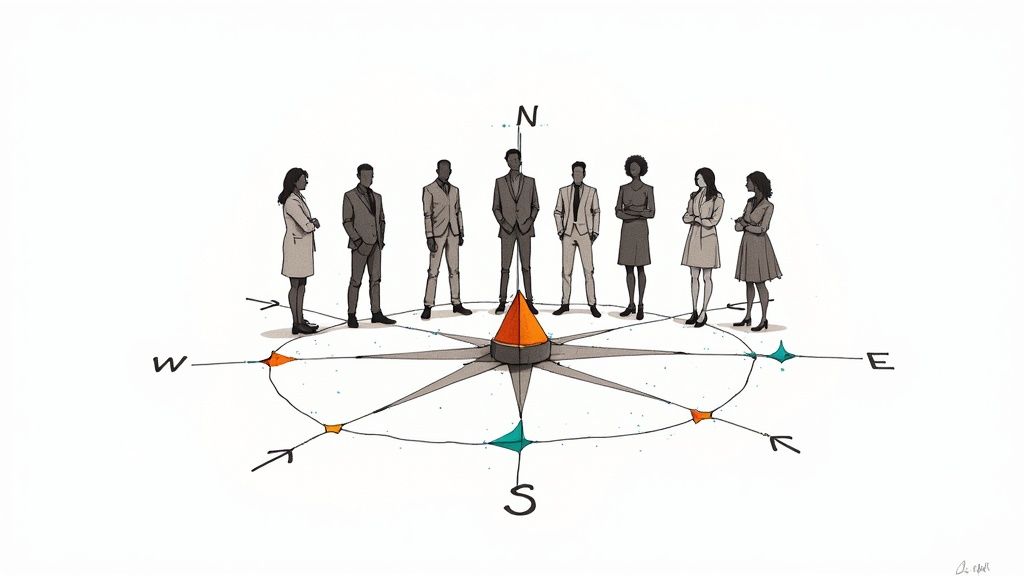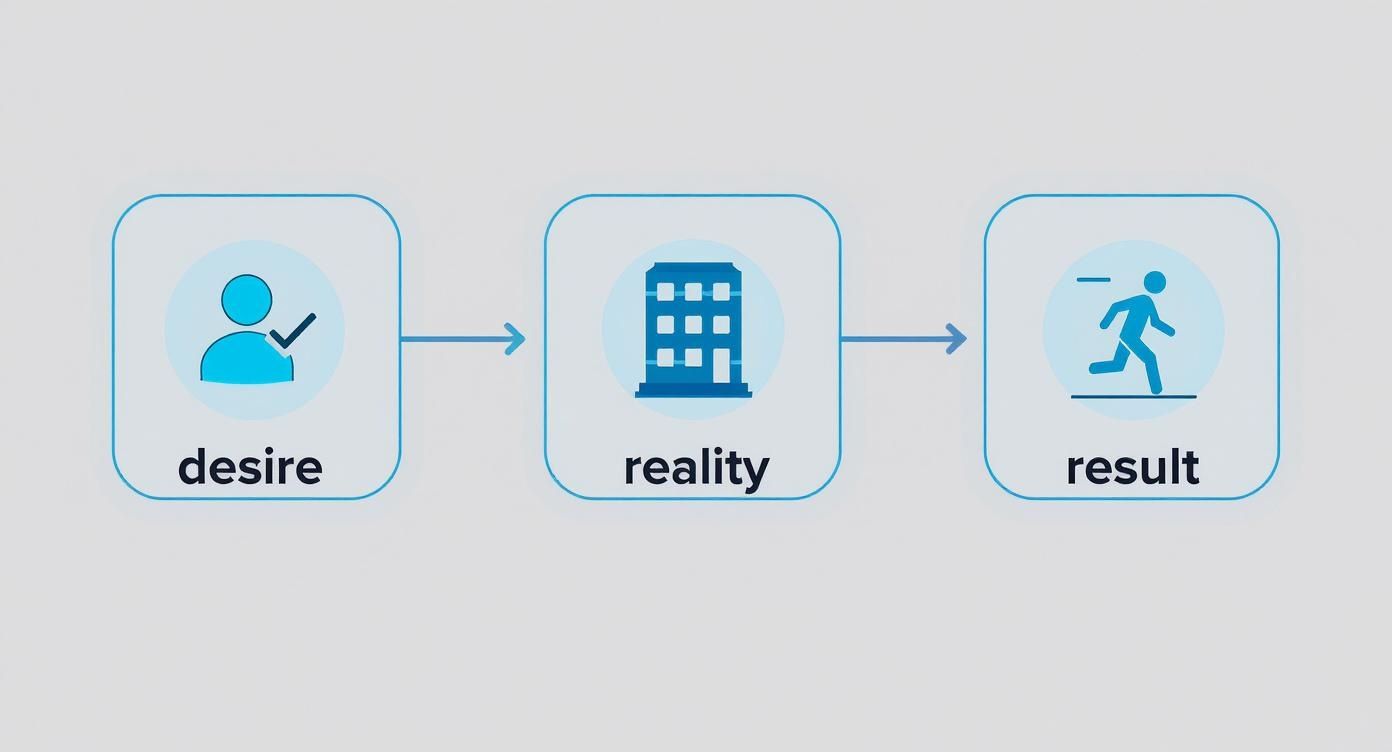What Are Workplace Values and Why They Matter

Workplace values are the bedrock of your company's culture. They're the core beliefs that shape every decision, every interaction, and every action your organization takes. Think of them as a shared compass, always pointing your team in the right direction and defining what truly matters in how you do business.
Unpacking What Workplace Values Really Mean

Imagine your company's values as its unique DNA. These aren't just trendy business goals or last quarter's targets; they are the deeply ingrained principles that give your organization its identity. They are the constant, guiding forces that stick around long after strategies shift.
These values help answer the tough questions about how your business really works. Do you champion relentless innovation, even if it means a few missteps, or is methodical perfection the goal? Is open, candid communication valued more than a traditional, top-down structure? The answers, driven by your values, create a reliable and consistent environment for employees, customers, and partners.
More Than Just Words on a Wall
Let's be honest—for values to mean anything, they have to be more than just pretty words plastered in the breakroom. They must be alive in the everyday actions of your team. When what you say you value matches what you do, you build trust and give people a real sense of purpose.
It's a common problem. A study from Gallup found that only about 20% of employees in the U.S. strongly agree that they are connected to their organization's culture. Why the disconnect? Often, it's because the values on the poster don't show up in the daily grind.
Workplace values are the blueprint, and company culture is the finished building. Values guide the behaviors, interactions, and systems that ultimately define what it feels like to work somewhere.
This is where the rubber meets the road. Authentic values aren't just stated; they're demonstrated. You can see them clearly in:
- Decision-Making: How leaders and teams make choices, especially when things get tough.
- Hiring and Promotion: The behaviors and attitudes that get recognized and rewarded.
- Team Interactions: The way people talk to each other, work together, and handle disagreements.
At the end of the day, these principles aren't just for creating a feel-good vibe. They are powerful tools that steer behavior, attract people who fit, and build an organization that can weather any storm. To dig deeper into laying this groundwork, take a look at our complete guide on defining company values.
How Values Drive Employee Engagement

When a team feels disengaged, it's rarely just about a lack of motivation. More often than not, it’s a sign that they’re disconnected from the company’s bigger purpose. Workplace values are the connective tissue that links an employee's day-to-day work with the organization's overarching mission. When someone’s personal principles line up with their employer's, a job stops being just a job—it becomes meaningful.
This sense of connection is more critical now than ever. The latest data shows that global employee engagement has sunk to just 21%, according to Gallup's State of the Global Workplace: 2022 Report. A huge driver of this decline is a weak connection to the organization's purpose, coupled with poor management and a lack of real teamwork. You can dig into more of these trends in Gallup’s comprehensive State of the Global Workplace report.
Turning Principles into Purpose
Authentic workplace values tackle the root causes of disengagement head-on. They can't just be words on a poster; they have to be principles that show up in how leaders act, how teams interact, and how company policies are written.
A values-driven culture offers clarity and consistency, which helps people feel secure and understood. This trust is the bedrock of any thriving team. When values are truly lived out, they create an environment where people feel a genuine bond with their work and with each other.
"Values are the invisible threads that weave a team together. When everyone pulls in the same direction, guided by shared principles, engagement is the natural result."
This shared direction cultivates a powerful sense of belonging. Employees who believe in what their company stands for are far more likely to be committed, proactive, and resilient when things get tough.
The Impact of Value Alignment
When an employee's personal values click with the company's, it's a game-changer. It creates an atmosphere where people feel respected for who they are, not just for the tasks they complete. This feeling of psychological safety opens the door to honest communication, better collaboration, and real innovation.
Think about how values directly boost engagement:
- Better Decision-Making: Clear values give everyone, from the front lines to the C-suite, the confidence to make decisions that move the company forward.
- Stronger Team Bonds: When everyone operates from the same ethical playbook, it minimizes friction and builds much stronger working relationships.
- Higher Retention: People stick around when they feel like their work is part of something bigger than themselves.
In the end, a strong set of workplace values is the engine that powers a lasting culture of engagement. To build this kind of environment, leaders have to make sure values aren't just defined—they must be woven into the fabric of daily work. You can explore our detailed guide on fostering a culture of engagement to learn more.
The Values That Attract Top Talent
In a job market buzzing with competition, a great salary is just table stakes. It's no longer the final word for top professionals. According to the World Bank, over 30 million new formal firms were registered worldwide between 2017 and 2021, and with millions more launching each year, employees have more choices than ever before. They’re looking past the paycheck and focusing on something far more meaningful: shared workplace values.
This shift is especially strong among Millennial and Gen Z workers, who now dominate the workforce. They aren't just looking for a job; they're looking for a purpose. According to a report from UJJI citing Gallup data, a staggering 70% of employees globally feel disengaged at work, often because their role feels hollow or lacks meaning. It’s no surprise, then, that they’re actively seeking employers whose principles genuinely align with their own.
The New Non-Negotiables for Modern Professionals
So, what are the workplace values that truly resonate today? Modern job seekers are prioritizing a culture built on more than just profit margins. They're drawn to organizations that genuinely champion transparency, inclusivity, and psychological safety.
These values have become powerful magnets for attracting and keeping skilled people. A company that is open about its challenges and successes builds a foundation of trust. In the same way, a workplace that celebrates diverse perspectives and ensures everyone feels safe enough to contribute their best ideas becomes a place where people want to build a long-term career.
Key Values That Make a Difference
Certain principles consistently rise to the top for today's best candidates. These aren't just buzzwords to put on a poster; they are the bedrock of a magnetic company culture where people feel seen, heard, and respected.
Here are a few of the core values that attract top talent:
- Trust and Transparency: This is all about open communication from leadership about company performance, clear paths for career growth, and an environment where feedback flows freely and honestly in all directions.
- Purpose-Driven Work: People want to see how their daily tasks connect to a larger mission. They are far more motivated when they feel their work contributes positively to the company's goals and maybe even to society.
- Inclusivity and Belonging: A culture where every single person feels they belong—regardless of their background, identity, or role—is non-negotiable. This goes way beyond simple diversity metrics to create true equity and a sense of community.
- Collaboration Over Competition: Top performers thrive in environments where teamwork is celebrated. They look for cultures that encourage sharing knowledge and succeeding together, not at the expense of others.
A strong set of values acts like a filter, attracting candidates who are not just skilled for the role but are also a great fit for the team. This alignment is crucial for long-term success and retention.
Organizations that truly live and breathe these values don't have to work as hard to find great people—great people find them. By weaving these principles into every part of the business, from recruiting to daily operations, you create an environment where top talent doesn't just work; they belong.
For more on this, our guide on hiring for culture fit offers detailed strategies to help you build that crucial alignment.
Putting Workplace Values Into Practice
Let's be honest: a list of values framed on the wall is useless. Words like "innovation" or "integrity" sound great in a mission statement, but they don't mean a thing until they show up in how people actually behave day-to-day. They have to live in team meetings, project kickoffs, and tough decisions.
This is where the rubber meets the road, and frankly, where most companies get it wrong. Gallup research tells a stark story: only about 20% of employees in the U.S. strongly agree they feel connected to their organization's culture. Why? Because there's a huge gap between the values leaders talk about and what employees experience every day.
To make values stick, you have to translate them from abstract ideas into a clear playbook of expected actions. It’s about showing everyone—from the newest hire to the CEO—exactly what it looks like to bring those values to life in their specific role.
From Abstract Concepts to Daily Actions
To bridge that gap, you have to get specific. What does a value like "collaboration" really look like on a Tuesday afternoon? It's not just about saying you value teamwork. It’s about intentionally building cross-functional teams, investing in tools like Slack or Microsoft Teams that tear down silos, and celebrating team wins over individual heroics.
The value becomes visible in the very way the company is set up to run.
The true test of a company's values isn't what's written in a handbook, but what's practiced, celebrated, and corrected every single day.
Defining these behaviors makes your cultural DNA tangible. It gives people a clear guide for making decisions, offering feedback, and working together. The table below breaks down a few common values to show how you can connect a big-picture idea to the small, consistent actions that truly define a culture.
From Abstract Concepts to Daily Actions
| Core Value | What It Means in Practice | Examples in Action |
|---|---|---|
| Innovation | Creating a space where new ideas are welcomed, experimentation is safe, and learning from failure is the norm. | - Hosting regular "hackathons" or brainstorming sessions. - Celebrating calculated risks, even if they don't pan out. - Giving teams a dedicated budget for experimental projects. |
| Transparency | Sharing the good, the bad, and the ugly about company performance, challenges, and decisions with everyone. | - Holding monthly "all-hands" meetings with a truly open Q&A. - Making team and company performance dashboards accessible. - Clearly explaining the 'why' behind major strategic shifts. |
| Accountability | Everyone taking ownership of their work, delivering on promises, and being answerable for outcomes—without excuses. | - Setting clear, measurable goals (like OKRs) for every team. - Running blameless post-mortems to learn from mistakes. - Leaders openly admitting when they've made a misstep. |
| Integrity | Doing the right thing with honesty and strong moral principles, especially when no one is watching or when it's hard. | - Walking away from a profitable client that doesn't align with your ethics. - Being upfront with customers about a product's limitations. - Ensuring all employees complete practical, scenario-based ethics training. |
Ultimately, this exercise transforms vague ideals into a practical roadmap. It’s how you ensure your values aren’t just decorations, but the very foundation of how work gets done.
Why Work-Life Balance Is a Core Value
The days of the "always-on" work culture being a badge of honor are over. In reality, it was just a fast track to burnout. Now, we're seeing a massive shift. Work-life balance has moved from a nice-to-have perk to an absolute deal-breaker for talented professionals who aren’t willing to sacrifice their well-being for a paycheck.
This isn't just a fleeting trend; it's a fundamental demand backed by hard data. The disconnect between what employees need and what companies provide is staggering. A Korn Ferry survey published in 2022 found that of the 59% of global employees working full-time from the office, only a tiny 19% actually want to be there. The report digs deeper, revealing that a lack of respect for personal time is a major reason people are heading for the exit. You can see more of their workforce management insights for the full picture.
Respect for Personal Time Is a Retention Strategy
Let's be blunt: companies that ignore the need for personal boundaries are losing their best people. When you expect your team to be available 24/7, trust disappears and resentment starts to simmer. It’s a slow burn that leads to disengagement, plummeting productivity, and eventually, a revolving door of talent.
Making work-life balance a core value means actively protecting your employees' time off the clock. This isn't about paying lip service to the idea; it requires building real policies and guardrails.
When a company respects an employee's time outside of work, it sends a powerful message: we value you as a whole person, not just as a resource. This respect is the foundation of a sustainable, high-performing team.
When you start thinking this way, work-life balance stops being an employee benefit and becomes a powerful strategic advantage for the entire business.
From Buzzword to Business Advantage
So what does it actually look like to live this value day-to-day? It’s about creating a culture where logging off at the end of the day is not just allowed but actively encouraged. It starts at the top, with leaders who model this behavior by taking their own vacations and respecting their team’s non-working hours.
This translates into concrete actions, like:
- Establishing a 'Right to Disconnect': This means having clear rules that protect employees from feeling obligated to check emails or take calls after their workday is done.
- Promoting Flexible Schedules: Give people options. Remote work, compressed workweeks, or flexible start and end times allow employees to fit their work around their lives, not the other way around.
- Focusing on Outcomes, Not Hours: Judge success by the quality of the output, not by the time someone spends glued to a chair.
To truly make this work, everyone from the top down needs to get on board with setting healthy work boundaries. When companies genuinely champion this principle, they don’t just survive; they thrive. They attract and keep motivated, resilient professionals who are committed for the long haul.
How to Build a Values-Driven Culture
Defining your workplace values is one thing; making them the lifeblood of your company is another entirely. A truly values-driven culture isn't something you can create by accident. It's the result of a conscious, continuous effort to turn those core principles into the actions your team takes every single day.
Without this effort, your values are just words on a wall.
This whole process has to start with authenticity. A Gallup poll found that only about 20% of U.S. employees strongly agree they feel connected to their company's culture. Why the disconnect? It's often because the "official" values don't line up with what people experience day-to-day. The only way to avoid this is to build your culture with your people, not just for them.
Discover and Define Your Core Values Collaboratively
The best, most meaningful values aren't dictated from the top down—they’re unearthed from within the organization. Forget the closed-door leadership meetings. Instead, bring your entire team into the conversation.
You can use surveys, workshops, and open discussions to get to the heart of what matters. Ask questions that get people thinking: What behaviors do we respect most in our coworkers? What principles are behind our most successful projects? When the pressure is on, what do we stand for?
This collaborative process does two things brilliantly. First, it ensures the values you land on are a true reflection of your company's identity. Second, it creates instant buy-in from the very people who will be living them out. Once you've collected everyone's input, your job is to boil it down into a handful of clear, memorable statements. Ditch the corporate jargon and aim for simple, powerful language that everyone can get behind.
This infographic perfectly captures the breakdown that happens when values (like work-life balance) are just talk, not reality.

As you can see, a gap between what an employee needs and what the company provides is a direct path to losing great people. This is why authentic integration is so critical.
Weave Values into the Employee Lifecycle
For your values to have any real staying power, they need to show up at every stage of the employee journey. Think of it as creating a consistent feedback loop where your principles are constantly reinforced.
Here’s how you can make that happen:
- Hiring and Recruiting: Don't just ask about skills. Design interview questions that dig into a candidate's alignment with your values. You're looking for people who not only have the talent but also share the mindset.
- Onboarding: Make your values a cornerstone of the new hire experience. Move beyond a quick mention in a handbook and share real stories of how your team brings them to life.
- Performance Reviews: Performance isn't just about hitting targets. Your review process should also assess how employees achieve their results, measuring their behaviors against the company's core principles.
- Recognition and Rewards: This is where you can really make your values shine. When you publicly celebrate and reward people for living out your values, you send a powerful message about what truly matters.
A values-driven culture is built through thousands of small, consistent actions over time. It’s reinforced in every hire, every promotion, and every public recognition.
Of course, none of this works without leadership setting the example. When employees see their managers and executives consistently modeling the right behaviors, those actions become the standard for everyone. If you're looking for more practical ideas, check out these top ways to improve workplace culture.
Ultimately, a strong culture is one of your most powerful assets. Our guide on building culture at work dives even deeper into creating an environment where your team can truly thrive.
Frequently Asked Questions About Workplace Values
As we wrap up our guide, let's tackle some of the most common questions that pop up when leaders and teams start defining their guiding principles. Getting these details right is the key to building a stronger, more connected team.
How Many Core Values Should We Have?
This is probably the number one question we hear. While there isn't a single magic number, the sweet spot for most companies is three to five core values.
Why that range? It's concise enough for everyone to remember and specific enough to actually guide decisions. Any fewer, and your values might be too broad to be meaningful. Any more, and they start to lose their punch, becoming just a long list that's impossible to live by day-to-day.
Aren't Values and Culture the Same Thing?
It’s easy to mix these two up, but they have a distinct relationship. Here’s a simple way to think about it:
Think of your workplace values as the blueprint and your company culture as the finished building.
Values are the core beliefs you intentionally choose and write down. Culture is what happens when those values are put into action—it’s the real-life environment created by everyone's behaviors, interactions, and decisions every single day. Your values guide, but your culture is the living, breathing result.
How Often Should We Revisit Our Values?
Finally, leaders often ask if values are a "set it and forget it" kind of thing. Not quite. While your core principles should have staying power, the world around you changes.
A good rule of thumb is to formally review your workplace values every two to three years.
You should also take a fresh look during major company shifts—like a period of explosive growth, a merger, or a significant change in strategy. These check-ins make sure your values still reflect who you are and where you're going, keeping them from becoming just outdated words on a forgotten "About Us" page.
Ready to build a culture where your values are more than just words on a wall? MyCulture.ai provides a science-backed platform to assess candidate alignment with your unique organizational values and behaviors. Generate tailored assessments in minutes to make data-driven hiring decisions, strengthen your teams, and build the cohesive, value-driven culture you’ve always wanted. Start building a stronger culture today.